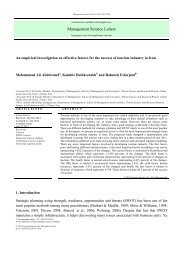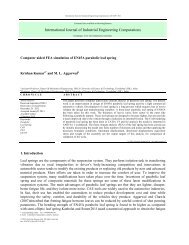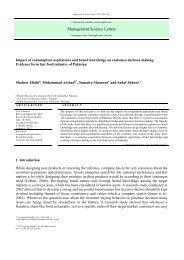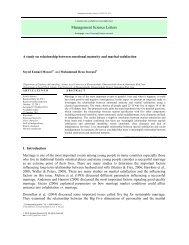PDF (276 K) - Growing Science
PDF (276 K) - Growing Science
PDF (276 K) - Growing Science
Create successful ePaper yourself
Turn your PDF publications into a flip-book with our unique Google optimized e-Paper software.
M. Kazemi et al. / International Journal of Industrial Engineering Computations 3 (2012)<br />
tardiness to capture the JIT philosophy, where the earliness costs depend on the start times of the jobs<br />
and tardiness costs depend on completion times. They applied an efficient representation of dominant<br />
schedules and introduced a polynomial algorithm to compute the best schedule for a given<br />
representation. By using local search algorithm and a branch-and-bound procedure, the authors<br />
showed there is a very small gap between their results and optimum solutions. Runge and Sourd<br />
(2009) addressed a new model for the single machine E/T scheduling problem where preemption is<br />
allowed. In this model, presented interruption costs are based on the WIP of the job. The WIP costs<br />
are based on the differences among the start and completion times of the jobs. This model presented<br />
two main advantages over an existing model HS presented by Hendel and Sourd (2005).<br />
Primary, HS does not penalize interruption in all cases. And the next advantage is that liberty among<br />
the E/T and the WIP costs allows them to design a new timing algorithm with a better time<br />
complexity. Also they discussed for several dominance rules and the particular case of the scheduling<br />
problem around a common due date. Furthermore, presented the lower bound for the timing<br />
algorithm and explained that a local search algorithm based on their new timing algorithm is sooner<br />
than a local search algorithm, which uses the timing algorithm presented by Hendel and Sourd<br />
(2005). Khorshidian et al. (2011) presented a new mathematical model in the expansion of the<br />
classical single machine E/T scheduling problem where preemption is allowed and idle time is also<br />
considered. The proposed model finds the sequence configuration with the aim of minimizing the<br />
scheduling costs. An efficient algorithm based on genetic algorithm (GA) was planned to solve the<br />
mathematical model. Schematic representation of literature review for problem definition is<br />
illustrated in Table 1.<br />
Table 1<br />
Scheduling attributes used in the present research and in a sample of published articles<br />
Authors<br />
Single<br />
machine<br />
Objective<br />
Preempti<br />
on jobs<br />
Ei Ti Others<br />
Seidmann et al. (1981) √ √ √ √<br />
Garey et al. (1988) √ √ √ √<br />
Bector et al. (1988) √ √ √<br />
Davis & Kanet (1993) √ √ √<br />
Nandkeolyar et al. (1993) √ √ √<br />
Ventura & Weng, (1994) √ √ √<br />
Szwarc & Mukhopadhyay (1995) √ √ √<br />
Hoogeveen & Van De Velde (1996) √ √ √<br />
Wan & Yen (2002) √ √ √<br />
Sourd and Kedad-Sidhoum (2003) √ √ √<br />
Tavakkoli-Moghaddam et al.(2005) √ √ √ √<br />
Hendel & Sourd (2006) √ √ √<br />
Esteve et al. (2006) √ √ √<br />
M’Hallah (2007) √ √ √<br />
Bülbül (2007) √ √ √ √ √<br />
Liao & Cheng (2007) √ √ √<br />
Gupta & Chantaravarapan (2008) √ √<br />
Sourd & Kedad-Sidhoum (2008) √ √ √ √ √<br />
Wan & Yen (2009) √ √<br />
Hendel et al., (2009) √ √ √ √ √<br />
Hepdogan et al. (2009) √ √ √<br />
Shirazi et al. (2010) √ √ √<br />
Khorshidian et al. (2011) √ √ √ √ √<br />
Proposed model in this paper √ √ √ √ √ √<br />
323<br />
Environ<br />
ment<br />
(JIT)








